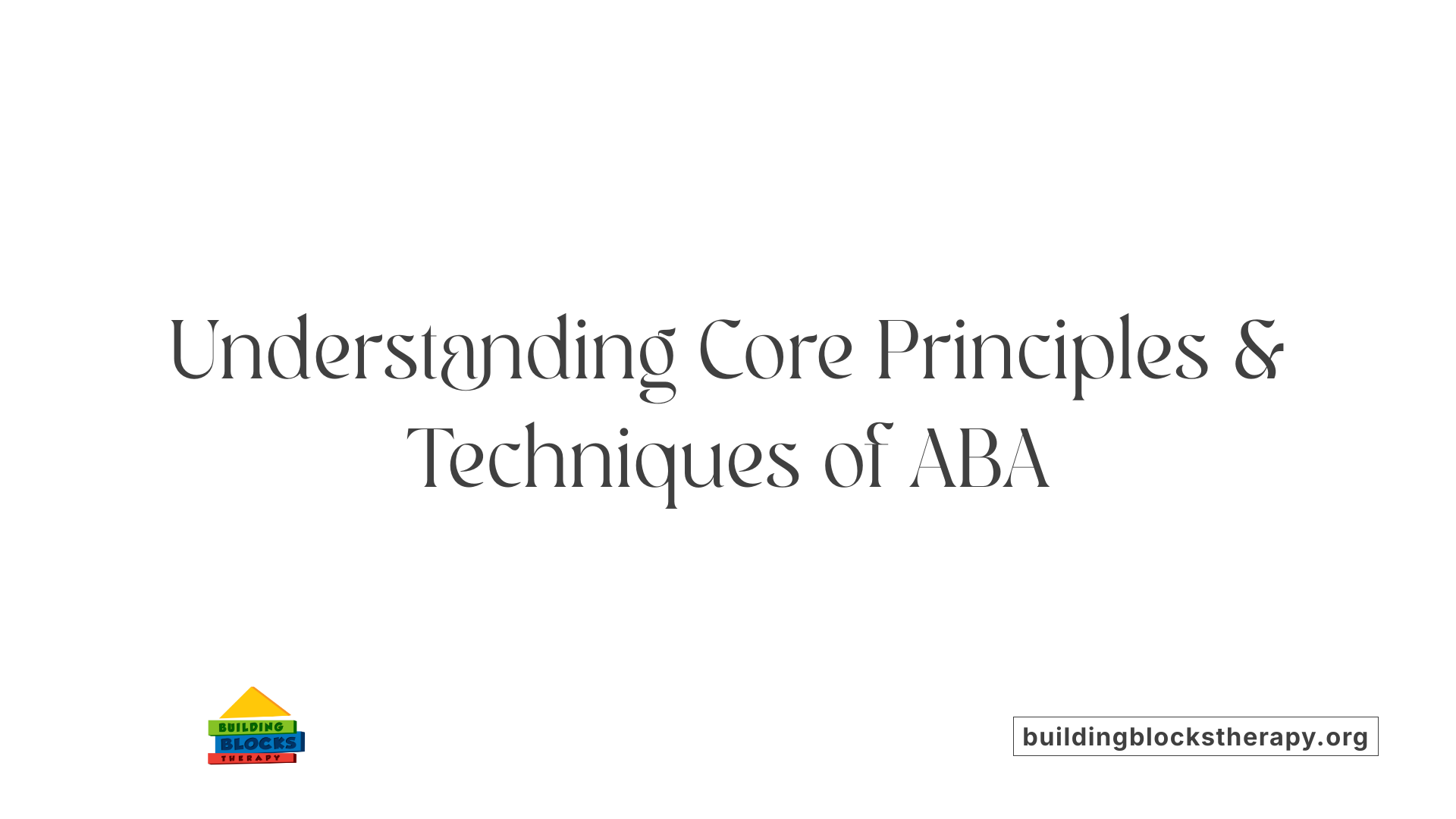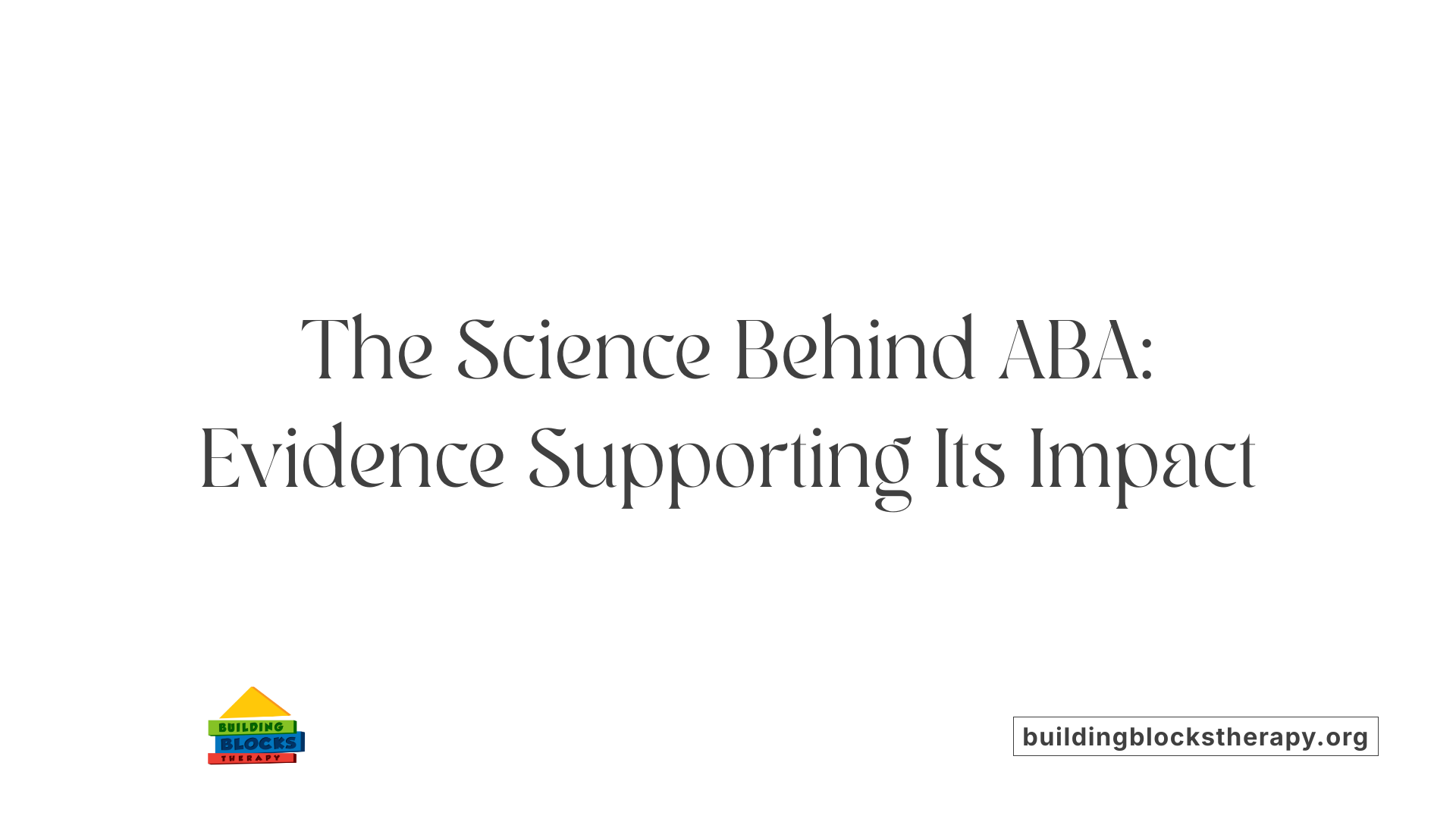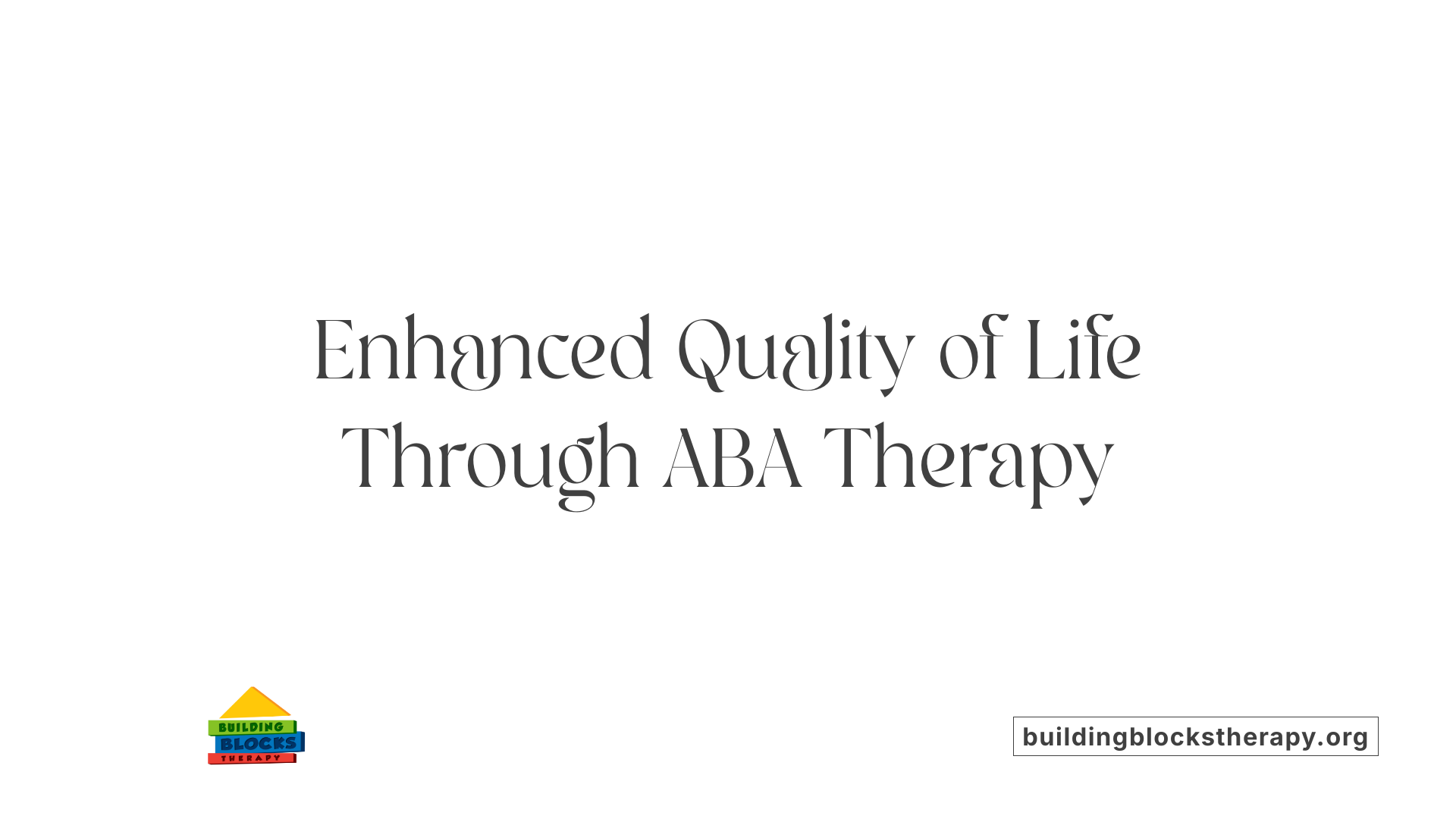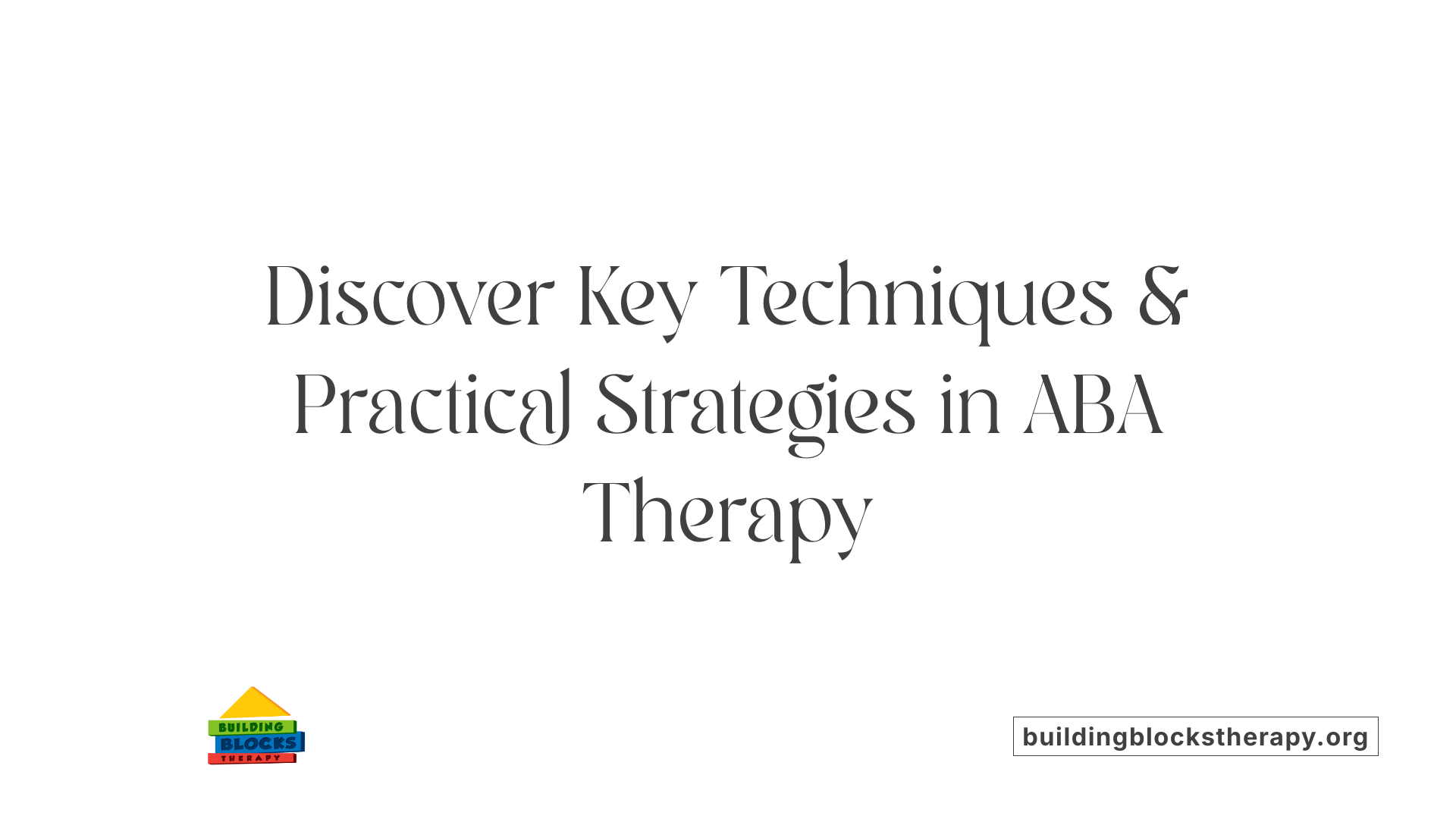Understanding ABA Therapy and Its Impact
Applied Behavior Analysis (ABA) therapy is recognized worldwide as a scientifically validated approach to helping children with autism spectrum disorder (ASD) develop essential skills and improve behaviors. Grounded in behavioral science, ABA employs specific techniques designed to support children’s development across communication, social, cognitive, and daily living domains, ultimately aiming to enhance their independence and quality of life.
Core Principles and Techniques of ABA Therapy

What are the fundamental principles and techniques of ABA therapy?
Applied Behavior Analysis (ABA) therapy is rooted in understanding that a person’s behavior is shaped by their environment. This scientific approach aims to modify behaviors by systematically applying techniques proven effective through extensive research.
One of the main methods used is positive reinforcement. When a desired behavior occurs, it is rewarded, which increases the likelihood that the behavior will happen again. This can include praise, tokens, or other incentives that motivate the individual.
ABA also involves analyzing the antecedents (what happens before a behavior) and consequences (what follows after). This is often referred to as the ABC model. Understanding these helps pinpoint what triggers problematic behaviors and how to reinforce positive alternatives.
Teaching strategies such as prompting, fading, and behavior chaining are used to develop complex skills. Prompting involves guiding the child toward the correct behavior, which is gradually faded as the skill becomes independent. Behavior chaining teaches a sequence of skills, from simple steps to complex routines, enabling real-world functioning.
Data collection is central to ABA, with every intervention customized based on individual needs. Programs are designed, monitored, and adjusted based on careful analysis of progress, making the approach data-driven. Qualified professionals, such as Board-Certified Behavior Analysts (BCBAs), oversee this process to ensure treatment is effective and tailored.
The goals of ABA include not only reducing harmful or disruptive behaviors but also teaching meaningful, functional skills like language, social interactions, daily living activities, and self-care. This comprehensive, scientific method ensures that behavioral improvements are sustainable and generalize across different environments.
| Principle/Technique | Description | Purpose |
|---|---|---|
| Positive Reinforcement | Rewards for desired behaviors | Increase helpful or appropriate behaviors |
| ABC Model | Analyzing antecedents and consequences to understand behavior | Identify triggers and reinforcement patterns |
| Prompting and Fading | Guided assistance gradually reduced to independence | Teach new skills step-by-step |
| Behavior Chaining and Modeling | Linking behaviors together in sequence and demonstrating behaviors | Develop complex skills and imitation abilities |
| Data-Driven Programs | Continuous data collection to guide intervention adjustments | Personalize treatment and improve outcomes |
Overall, ABA therapy combines these principles and techniques to create individualized programs that promote learning, independence, and socially meaningful behavior changes for individuals with autism and other developmental challenges.
How ABA Therapy Promotes Development across Key Areas
How does ABA therapy help children with autism develop communication, social, and daily living skills?
ABA therapy plays a vital role in helping children with autism build essential skills across multiple areas. It accomplishes this by breaking down complex behaviors into small, achievable steps. These steps are reinforced with positive rewards, encouraging children to practice and master each new skill.
In the area of communication, ABA employs techniques such as picture exchange systems and verbal behavior strategies. These methods help children learn to use words, gestures, or alternative communication devices to express their needs and understand others. This focus on language development enhances their ability to initiate conversations, respond appropriately, and understand social cues.
Social skills are another critical component. ABA encourages peer interactions through structured activities that teach turn-taking, sharing, and recognizing emotions. Children learn how to make friends, interpret body language, and respond to social situations effectively, fostering meaningful relationships.
Daily living skills are equally emphasized. ABA programs aim to teach independence in activities like toileting, dressing, self-grooming, and establishing sleep routines. These routines are introduced gradually, with consistent reinforcement, to build confidence and autonomy.
Because ABA therapy is tailored to each child's needs and relies on ongoing data collection, progress is continuous and measurable. This personalized approach ensures that the child’s developmental trajectory aligns with their unique strengths and challenges, leading to tangible improvements in communication, social interactions, and independence.
Overall, ABA provides a comprehensive framework for supporting children with autism in acquiring crucial skills that enhance their ability to navigate the world confidently and independently.
| Skill Area | Methods Used | Expected Outcomes | Additional Notes |
|---|---|---|---|
| Communication | Verbal behavior, picture exchange | Express needs, understand language, initiate contact | Focus on functional, everyday use |
| Social Skills | Peer interaction, social cues | Making friends, understanding emotions | Group settings and role-playing |
| Daily Living Skills | Reinforcement, step-by-step routines | Toileting, dressing, sleep independence | Promotes self-reliance |
| Individualized Interventions | Data tracking, goal-setting | Continuous progress tailored to child’s needs | Flexibility to adapt over time |
This comprehensive approach ensures children with autism develop the communication, social, and daily living skills necessary for greater independence and quality of life.
Scientific Evidence Supporting ABA's Effectiveness
 Research and meta-analyses consistently demonstrate the positive impact of Applied Behavior Analysis (ABA) therapy on children with autism spectrum disorder (ASD). Studies aggregate data from multiple sources to evaluate improvements in speech, social skills, and adaptive behaviors.
Research and meta-analyses consistently demonstrate the positive impact of Applied Behavior Analysis (ABA) therapy on children with autism spectrum disorder (ASD). Studies aggregate data from multiple sources to evaluate improvements in speech, social skills, and adaptive behaviors.
One significant finding from these analyses is that children undergoing ABA therapy show marked developmental gains. For example, effect size figures reveal substantial improvements: intellectual functioning (g=0.74), communication skills (g=0.74), and socialization (g=0.44). These metrics highlight the considerable influence ABA has on key areas of development.
Long-term benefits are also well-supported, especially when early and intensive interventions are implemented. Starting ABA therapy between ages 2 and 6 and maintaining a high hours-per-week schedule significantly enhances the child's progress. Children who receive more than 20 hours of ABA per week before age 4 demonstrate larger gains, including improved language abilities, self-care skills, and social interactions.
The evidence underscores that consistent, prolonged ABA interventions can lead to meaningful, lasting improvements. Children with diverse baseline abilities, including those with lower adaptive functioning, tend to benefit greatly, often achieving skills necessary for greater independence. These studies collectively affirm that ABA remains an essential, evidence-based approach in promoting positive outcomes for children with ASD.
| Evidence Area | Outcomes | Effect Size | Additional Information |
|---|---|---|---|
| Speech and Language Development | Improved expressive and receptive language | g=0.74 | Includes gains in initiating conversations and understanding speech |
| Social Skill Enhancement | Better peer interactions and emotional regulation | g=0.44 | Facilitates making friends and understanding social cues |
| Adaptive Behaviors | Increased independence in daily tasks | N/A | Skills like dressing, toileting, and household activities |
| Long-term Developmental Gains | Reduced need for special services | N/A | Notable improvements in IQ, language, and adaptive functioning |
This body of evidence supports the notion that ABA therapy is an effective, science-based treatment. It underscores the importance of early implementation and adequate intensity to maximize developmental gains, ultimately helping children with autism lead more independent and fulfilling lives.
Positive Outcomes and Long-term Benefits of ABA
What positive behavioral, developmental, and independence outcomes are associated with ABA therapy?
ABA therapy is highly effective in producing positive changes across various areas of functioning for individuals with autism spectrum disorder (ASD). Research shows that children undergoing early, intensive ABA often make significant strides in communication, social interactions, and daily living skills. These improvements include better language development, enhanced social skills like making eye contact and initiating conversations, and increased independence in activities such as dressing, grooming, and using the toilet.
Furthermore, ABA has proven beneficial in reducing challenging behaviors such as tantrums, aggression, or self-injury by understanding their triggers and teaching appropriate replacement behaviors. Longer and more consistent treatment programs, especially those exceeding 20 hours weekly, are associated with substantial gains in intellectual functioning, academic performance, and adaptive skills.
Early intervention within critical developmental periods, particularly before age 4, tends to result in remarkable progress. Additionally, children with lower baseline adaptive skills see more noticeable improvements after approximately two years of therapy, emphasizing the importance of personalized, long-term treatment plans.
How does ABA therapy boost independence in daily activities?
One of the main goals of ABA is to foster independence by teaching crucial life skills. These include personal hygiene routines like brushing teeth, bathing, and dressing, as well as fundamental skills such as sleeping through the night and using the bathroom independently.
ABA employs step-by-step teaching methods, visual aids, and positive reinforcement to help children master these routines. As they gain competence, children develop confidence in their abilities, which encourages further skill acquisition and decision-making autonomy. This not only improves their quality of life but also eases the caregiving burden.
Moreover, developing self-help skills through ABA enables children to participate actively in household chores, manage time effectively, and make simple choices. Overall, this increased independence supports better integration into family life, school, and community settings.
How does ABA therapy contribute to the reduction of challenging behaviors?
A significant benefit of ABA therapy is its ability to address disruptive behaviors that impede learning and socialization. By analyzing the functions of behaviors like tantrums, aggression, or repetitive movements, therapists can implement targeted strategies to decrease their occurrence.
Techniques such as positive reinforcement for appropriate behavior and natural environment training help children learn alternative behaviors that serve the same purpose as problematic ones. Over time, this reduces incidences of challenging behaviors and creates a calmer, more structured environment conducive to learning.
Effective behavior management through ABA enhances emotional regulation and social engagement, allowing children to participate more fully in everyday activities and interactions.
What long-term skill retention and confidence benefits are seen with ABA?
The skills gained from ABA therapy are durable and tend to persist well beyond the immediate treatment period. Because ABA emphasizes reinforcement and generalization of skills across settings, children often retain these new abilities as they grow.
As children master communication, social, and daily living skills, they develop a sense of competence and independence, which boosts self-confidence. This increased confidence motivates children to explore and participate actively in different environments, fostering further development.
Studies indicate that the foundation built through early, consistent ABA intervention leads to improved educational and employment opportunities in adulthood. In essence, ABA not only helps children acquire skills but also supports their lifelong journey toward autonomy and fulfillment.
| Outcome Area | Improvements Observed | Supporting Details |
|---|---|---|
| Communication | Enhanced verbal and nonverbal skills | Increased use of words, understanding language, and building peer relationships |
| Social Skills | Better peer interactions | Making eye contact, turn-taking, and understanding emotions |
| Adaptive Behaviors | Daily living skills | Dressing, grooming, toileting, sleeping independently |
| Challenging Behaviors | Decreased frequency | Reduction in tantrums, aggression, self-injury |
| Confidence & Independence | Greater self-reliance | Managing own routines, making choices, participating in community activities |
Overall, ABA continues to be regarded as the gold standard for supporting positive and lasting change in children with autism, equipping them with vital skills for a successful, autonomous life.
Supporting Skill Acquisition and Behavior Change
How does ABA therapy support skill acquisition and behavior improvement in children with ASD?
ABA (Applied Behavior Analysis) therapy is highly effective in helping children with autism develop new skills and improve behaviors through a range of targeted strategies. Central to this approach are structured, individualized learning plans known as Skill Acquisition Plans (SAPs). These plans carefully divide complex skills—such as communication, social interactions, and daily living activities—into smaller, manageable steps.
ABA uses techniques like task analysis to identify each step involved in a skill. Prompting—such as visual cues or physical guidance—is used initially to encourage the desired behavior. Over time, these prompts are systematically faded or gradually removed through a process called prompting fading, encouraging the child to perform the skill independently.
Monitoring progress is vital to ABA success. Continuous data collection helps therapists and families see how well a child is learning and whether changes to the plan are needed. This detailed tracking ensures that interventions are tailored to each child’s evolving needs and that skills aren’t just learned in one setting but are generalized across environments like home, school, and community.
The ultimate goals of ABA in this context are twofold: to promote the acquisition of essential skills—such as speaking, understanding others, self-care, and academic abilities—and to reduce harmful or disruptive behaviors. By identifying the function of problematic behaviors, ABA teaches functional alternative behaviors that serve the same purpose, thus decreasing maladaptive actions.
Another essential aspect of ABA is promoting generalization. Children are encouraged to apply newly learned skills in various settings and with different people, which solidifies their independence and functional use of these skills in everyday life.
In summary, ABA therapy’s structured, data-driven methodology not only facilitates skill acquisition but also fosters meaningful behavior change. It empowers children with autism to become more self-reliant and socially capable, laying a foundation for improved life quality and greater independence.
Advantages of ABA in Improving Quality of Life

What are the advantages of ABA therapy in enhancing the quality of life for children with autism?
ABA therapy is a highly effective, science-based treatment that offers a wide range of benefits for children on the autism spectrum. It assists in developing essential skills such as communication, social interaction, and independence, which are critical for daily living. Through personalized programs tailored to each child's needs, ABA helps reduce challenging behaviors like tantrums or aggression by understanding their functions and teaching appropriate replacement behaviors.
One of the key strengths of ABA is its foundation in evidence-based techniques, including positive reinforcement, natural environment training, and direct instruction. These methods encourage children to try new behaviors, build social confidence, and improve language skills like understanding body language or engaging in conversations.
Early intensive ABA intervention, especially before age 4, has been linked to significant developmental progress. It can help children learn vital life skills such as toileting, sleeping through the night, and dressing, promoting independence and reducing reliance on caregivers.
Moreover, ABA supports children in building friendships, participating in social activities, and becoming more engaged in their communities. The therapy also empowers families by providing effective strategies to manage behaviors at home, strengthen relationships, and support ongoing development.
In summary, ABA helps children reach their full potential by fostering independence, enhancing social and communication skills, and reducing behaviors that interfere with learning. The overall result is a better quality of life, greater confidence, and increased ability to advocate for themselves in various environments.
Techniques and Practical Applications of ABA

What are some common techniques used in ABA therapy?
Applied Behavior Analysis (ABA) employs a variety of structured strategies aimed at understanding and changing behavior. One of the most fundamental techniques is positive reinforcement. This involves rewarding behaviors that are desired, which encourages individuals to repeat these behaviors more frequently. Rewards can include praise, tokens, or other preferred items that motivate the individual.
Prompting and fading are also widely used. Prompting involves providing cues or hints to help initiate a behavior, such as gestures, verbal hints, or visual aids. As competence increases, these prompts are gradually faded, or removed, to foster independent performance of the skill.
Visual modeling and tools like charts or videos are particularly effective, especially for visual learners. These prepare individuals to imitate behaviors or responses accurately.
Complex behaviors are broken down into manageable steps through behavior chaining. This step-by-step process helps teach multi-part skills like dressing or brushing teeth by linking simple actions into a complete task.
Behavior contracts are written agreements between the therapist and individual that specify expected behaviors and potential rewards, establishing clear goals and accountability.
Other techniques include prompting to guide behavior, extinction to reduce or eliminate problematic behaviors, and script fading to improve social exchanges and conversational skills.
All these strategies work together in a tailored manner to promote positive behaviors, improve communication, and lessen challenging behaviors, supporting each individual’s development and independence.
Expanding Access and Adaptability of ABA

Is ABA therapy suitable only for autism or for other developmental needs as well?
ABA therapy is not limited exclusively to autism. While it is widely recognized as the most effective, evidence-based treatment for children with autism spectrum disorder (ASD), its principles are applicable to a broader range of developmental and behavioral challenges.
Many individuals with intellectual disabilities, traumatic brain injuries, ADHD, or anxiety disorders can benefit from ABA strategies. The therapy emphasizes skill development, behavior reduction, and promoting independence, making it versatile for various needs.
ABA techniques are adaptable for people of all ages, from early childhood to adulthood. For instance, adults can use ABA approaches to improve vocational skills, social interactions, or manage behaviors related to specific conditions.
This flexibility allows practitioners to customize programs to suit each individual's developmental level, strengths, and goals. Whether the goal is communication, self-care, or social skills, ABA can be tailored effectively.
Overall, ABA is a comprehensive, scientifically supported approach that extends its benefits well beyond autism to support a wide range of developmental needs and behavioral issues.
Enhancing Lives through Evidence-Based Practice
ABA therapy stands out as a groundbreaking, scientifically supported intervention that consistently produces meaningful improvements in the lives of children with autism. By fostering skill development, reducing maladaptive behaviors, and promoting independence, ABA empowers individuals to reach their full potential. Its individualized, data-driven approach ensures that interventions are tailored to each child's unique needs, making it a versatile and effective tool for improving quality of life across developmental stages and settings. Early intervention and ongoing support open pathways for children to thrive academically, socially, and personally, ultimately transforming their futures and enriching their families' lives.
References
- Applied Behavior Analysis (ABA) | Autism Speaks
- The Top 10 Reasons Children With Autism Deserve ABA - PMC
- Applied Behavior Analysis (ABA) - Cleveland Clinic
- 6 Life-Changing Benefits of ABA Therapy for Children with Autism
- Benefits of ABA Therapy for Children with Autism
- 5 Benefits Of ABA Therapy For Autism - Surpass Behavioral Health
- 5 Benefits of ABA Therapy for Autistic Child






